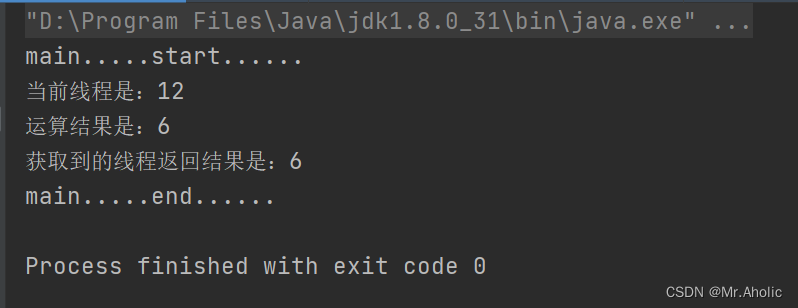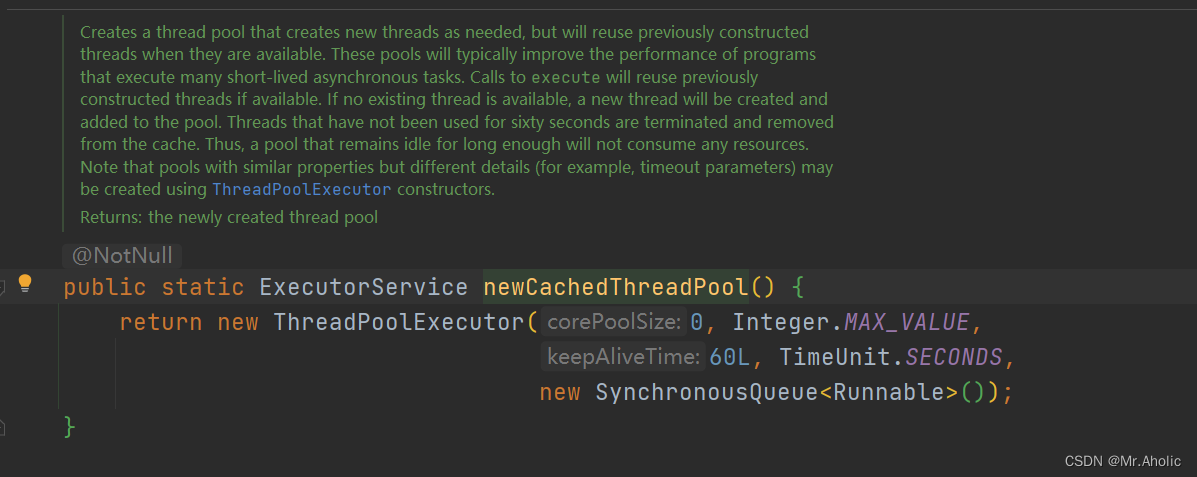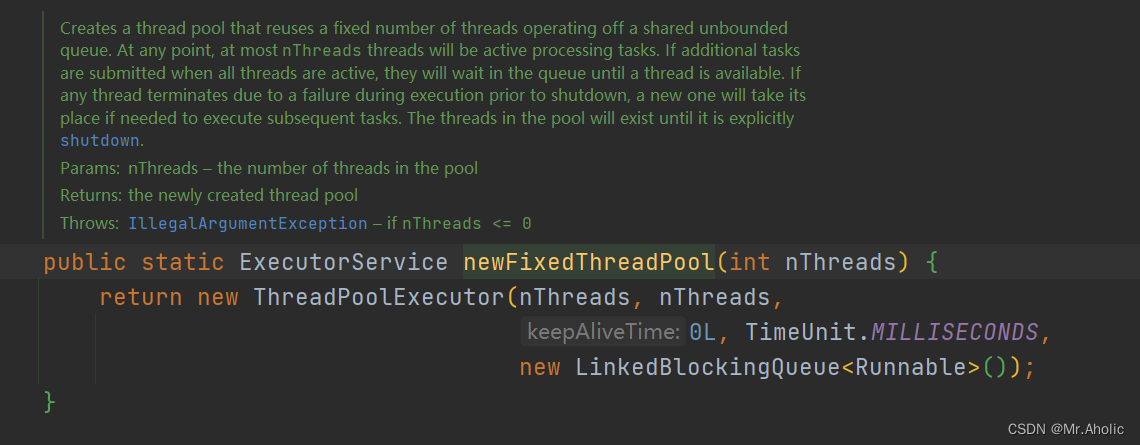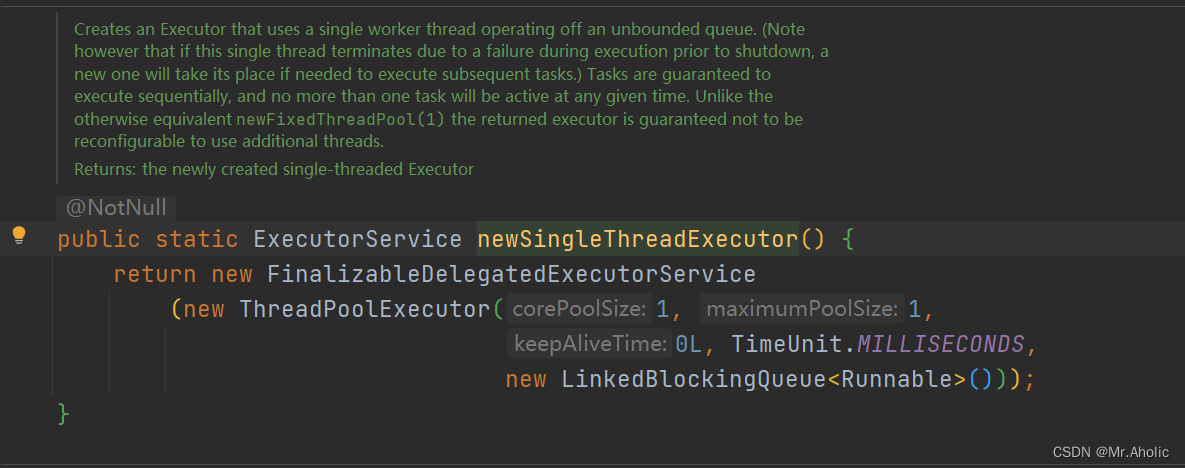
一、线程回顾
1、初始化线程的 4 种方式
1)、继承 Thread
2)、实现 Runnable 接口
3)、实现 Callable 接口 + FutureTask (可以拿到返回结果,可以处理异常)
4)、线程池
提示
- 方式 1 和方式 2:主进程无法获取线程的运算结果。不适合当前场景
- 方式 3:主进程可以获取线程的运算结果,但是不利于控制服务器中的线程资源。可以导致服务器资源耗尽。
- 方式 4:通过如下两种方式初始化线程池
Executors.newFiexedThreadPool(3);
//或者
new ThreadPoolExecutor(corePoolSize, maximumPoolSize, keepAliveTime, TimeUnit unit, workQueue, threadFactory, handler);
通过线程池性能稳定,也可以获取执行结果,并捕获异常。但是,在业务复杂情况下,一个异步调用可能会依赖于另一个异步调用的执行结果
1.1 继承 Thread
public class ThreadTestDemo {
public static void main(String[] args) {
System.out.println("main.....start......");
Thread01 thread01 = new Thread01();
thread01.start(); //启动线程
System.out.println("main.....end......");
}
public static class Thread01 extends Thread{
@Override
public void run() {
System.out.println("当前线程是:"+Thread.currentThread().getId());
int i = 8 / 2;
System.out.println("运算结果是:"+i);
}
}
}
结果

1.2 实现 Runnable 接口
public class ThreadTestDemo {
public static void main(String[] args) {
System.out.println("main.....start......");
Runnable01 runnable01 = new Runnable01();
new Thread(runnable01).start();
System.out.println("main.....end......");
}
/**
* 实现 Runnable 接口
*/
public static class Runnable01 implements Runnable{
@Override
public void run() {
System.out.println("当前线程是:"+Thread.currentThread().getId());
int i = 10 / 2;
System.out.println("运算结果是:"+i);
}
}
}

1.3 实现 Callable 接口
public class ThreadTestDemo {
public static void main(String[] args) throws ExecutionException, InterruptedException {
System.out.println("main.....start......");
FutureTask<Integer> futureTask = new FutureTask<>(new Callable01());
new Thread(futureTask).start();
//阻塞等待整个线程执行完成,获取返回结果
Integer integer = futureTask.get();
System.out.println("获取到的线程返回结果是:"+integer);
System.out.println("main.....end......");
}
/**
* 实现 Callable 接口 + FutureTask (可以拿到返回结果,可以处理异常)
*/
public static class Callable01 implements Callable<Integer>{
@Override
public Integer call() throws Exception {
System.out.println("当前线程是:"+Thread.currentThread().getId());
int i = 12 / 2;
System.out.println("运算结果是:"+i);
return i;
}
}
}
测试结果

1.4 线程池
public class ThreadTestDemo {
public static ExecutorService executor = Executors.newFixedThreadPool(10);
public static void main(String[] args) throws ExecutionException, InterruptedException {
System.out.println("main.....start......");
//提交给线程池去执行
executor.execute(new Runnable01());
System.out.println("main.....end......");
}
/**
* 实现 Runnable 接口
*/
public static class Runnable01 implements Runnable{
@Override
public void run() {
System.out.println("当前线程是:"+Thread.currentThread().getId());
int i = 10 / 2;
System.out.println("运算结果是:"+i);
}
}
}
执行结果

2、线程池的七大参数
2.1 参数说明
* @param corePoolSize the number of threads to keep in the pool, even
* if they are idle, unless {
@code allowCoreThreadTimeOut} is set
池中一直保持的线程的数量,即使线程空闲。除非设置了 allowCoreThreadTimeOut
* @param maximumPoolSize the maximum number of threads to allow in the
* pool
池中允许的最大的线程数
* @param keepAliveTime when the number of threads is greater than
* the core, this is the maximum time that excess idle threads
* will wait for new tasks before terminating. 当线程数大于核心线程数的时候,线程在最大多长时间没有接到新任务就会终止释放,
最终线程池维持在 corePoolSize 大小
* @param unit the time unit for the {
@code keepAliveTime} argument
时间单位
* @param workQueue the queue to use for holding tasks before they are
* executed. This queue will hold only the {
@code Runnable}
* tasks submitted by the {
@code execute} method. 阻塞队列,用来存储等待执行的任务,如果当前对线程的需求超过了 corePoolSize
大小,就会放在这里等待空闲线程执行。
* @param threadFactory the factory to use when the executor
* creates a new thread
创建线程的工厂,比如指定线程名等
* @param handler the handler to use when execution is blocked
* because the thread bounds and queue capacities are reached
拒绝策略,如果线程满了,线程池就会使用拒绝策略。

2.2 运行流程
- 1、线程池创建,准备好 core 数量的核心线程,准备接受任务
- 2、新的任务进来,用 core 准备好的空闲线程执行。
- (1) 、core 满了,就将再进来的任务放入阻塞队列中。空闲的 core 就会自己去阻塞队列获取任务执行
- (2) 、阻塞队列满了,就直接开新线程执行,最大只能开到 max 指定的数量
- (3) 、max 都执行好了。Max-core 数量空闲的线程会在 keepAliveTime 指定的时间后自动销毁。最终保持到 core 大小
- (4) 、如果线程数开到了 max 的数量,还有新任务进来,就会使用 reject 指定的拒绝策略进行处理
- 3、所有的线程创建都是由指定的 factory 创建的。
3、常见的 4 种线程池
-
newCachedThreadPool
- 创建一个可缓存线程池,如果线程池长度超过处理需要,可灵活回收空闲线程,若无可回收,则新建线程。
-
newFixedThreadPool
- 创建一个定长线程池,可控制线程最大并发数,超出的线程会在队列中等待。
-
newScheduledThreadPool
- 创建一个定长线程池,支持定时及周期性任务执行。
-
newSingleThreadExecutor
- 创建一个单线程化的线程池,它只会用唯一的工作线程来执行任务,保证所有任务按照指定顺序(FIFO, LIFO, 优先级)执行。

3.1 newCachedThreadPool

3.2 newFixedThreadPool

3.3 newScheduledThreadPool

3.4 newSingleThreadExecutor

4、开发中为什么使用线程池
-
降低资源的消耗
- 通过重复利用已经创建好的线程降低线程的创建和销毁带来的损耗
-
提高响应速度
- 因为线程池中的线程数没有超过线程池的最大上限时,有的线程处于等待分配任务的状态,当任务来时无需创建新的线程就能执行
-
提高线程的可管理性
- 线程池会根据当前系统特点对池内的线程进行优化处理,减少创建和销毁线程带来的系统开销。无限的创建和销毁线程不仅消耗系统资源,还降低系统的稳定性,使用线程池进行统一分配